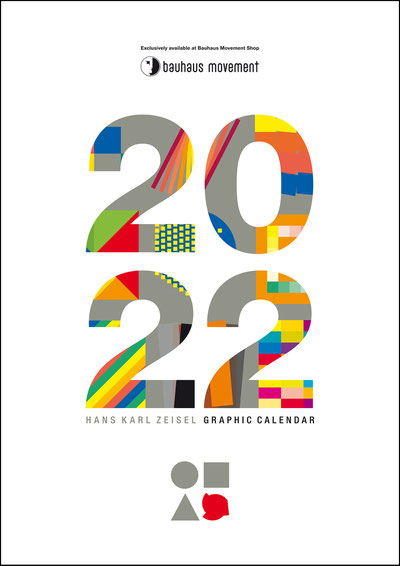Kalender

Fascinating rhythm
Fascinating rhythm, you’ve got me on the go
Fascinating rhythm, I’m all a-quiver
What a mess you’re making, the neighbors want to know
Why I’m always shaking, just like a fliver.
Each morning I get up with the sun
Start a-hopping, never stopping
To find at night no work has been done...
Jamie Cullum
12 Monate, 12 Grafiken, 12 mal die Möglichkeit, sich 30 Tage lang mit einem Blatt auseinanderzusetzen – wie schön, dass die Hans Karl Zeisel Grafik-Kalender jetzt auch im Shop von Bauhaus Movement erhältlich sind! 12 neue Arbeiten von Hans Karl Zeisel. Fein, delikat und bisher unveröffentlicht; das Jahr kann also beginnen…
… aber was wird es bringen? Wer das künstlerische Schaffen von Hans Karl Zeisel kennt, mag erstaunt sein. Denn keine der charakteristischen Verschmelzungen von Kreissegment, Dreieck und Quadrat, keine der Segmentierungen oder numerischen Größenkombinationen findet sich hier in gewohnter Weise wieder. Und doch ist das Gefüge der Grafiken dem verpflichtet. Ihre Grundform ist immer das Quadrat, das Formenspiel stets geometrisch bestimmt und die Schattierungen der Farbpalette entfalten sich überall in Bezug auf die Grundfarben Rot, Blau und Gelb. Zudem ist ihnen jener zirzensische Humor inne, jene Freude an der Form, jenes Wissen-Wollen-Wie-Etwas-Aussieht, das ein so großer Bestandteil des Schaffens Zeisels ist.
Während er bei seinen Collagen, Malereien und Objekten gerne mit Materialien und Techniken experimentiert, sind die vorliegenden Grafiken am Computer erzeugt. Auch dieses Medium versteht er mit meisterlicher Finesse zu nutzen! Und so entstehen Verläufe, Reihungen, Verschachtelungen, Spiegelungen, Verschiebungen, Zentrierungen, es entstehen diagonale, farbige, ver-rückte, auf der Kippe stehende Ordnungen und Unordnungen. Wieder und wieder neu, wieder und wieder anders. Wiederholungen versucht er ebenso zu vermeiden, wie das wissenschaftliche Bestreben alle kombinatorisch möglichen Formen aufzuzeigen. Jede dieser Arbeiten steht für sich. Keine bedarf einer Serie, keine ein Ensemble oder eine Reihung zur Bestätigung. Der August etwa; ein sich Fortsetzen der Kippbewegung wäre hier vorstellbar. Aber die Grafik steht als Solitär. Sie ist kein Teil eines optischen Experiments. Auf den ersten Blick ist die Komposition eindeutig, streng und logisch. Die gegenläufige Anordnung der blauen und roten Balken vor einem gelben Rechteck aber, wird irritierend unterlaufen durch das Aus-der-Reihe-Kippen jeweils eines farbigen Balkens. Logisch und verquer zu gleich. Rhythmisch und arhythmisch in einem Takt. Synkopisiert. Irgendwie jazzy und womöglich durchwebt von einem Hauch unbeschwerten und übermütigen Sommers. Ähnlich der März – Quadrate raufen sich hier diagonal verschoben zusammen, bringen das geometrische Gefüge in Bewegung, ja brechen daraus heraus. Im Gegensatz dazu ist der April geprägt durch eine verdichtende Schachtelung, der Juni gar verwirrt, während der September in seinem diagonal geordneten Liniement Ruhe ausstrahlt, Ruhe und eine vordergründig einleuchtende Ordnung.
Hans Karl Zeisel zeigt mit diesen Arbeiten einmal mehr die unerschöpfliche Vielfalt seiner konkreten Formenwelten. Und er lädt wieder dazu ein, ein ganzes Jahr diesem Zusammenspiel und Rhythmus von Kreis, Quadrat, Linie, Dreieck und Farbe zu folgen. Mehr bräuchte es nicht für ein Jahr mit Kunst, für ein Jahr mit Hans Karl Zeisel.
Dr. Annette Schmidt
12 months, 12 graphics, 12 possibilities to take a conscious look at a print for thirty days—how wonderful, the graphic calendars by Hans Karl Zeisel are now available at the Bauhaus Movement shop! 12 new works by Hans Karl Zeisel. Fine, delicate, and previously unreleased; what a start to a new year …
… but what will it have in store? If you are familiar with the artistic work of Hans Karl Zeisel, you may be amazed. For there are none of the characteristic mergings of circular segments, triangles and squares, none of the segmentations or numeric combinations of sizes will be found here as per usual. And yet, one can see the obligation to that in the structure of the graphics. Their basic shape is always the square, their play of shapes is constantly determinedly geometrical, and the shades of the colour palette are unfolding everywhere in relation to the primary colours red, blue, and yellow. Furthermore they hold the kind of circensic humour, that joy of form, that wanting-to-know-what-something-will-look-like, which is such a huge part of Zeisels work.
While he likes to experiment with different materials and techniques on his collages, paintings and objects, he created these graphics on a computer. Just another medium he knows to use with masterly finesse! Resulting in gradients, sequences, nested structures, reflections; in diagonal, colourful, shifting, hanging in balance kind of systems of order and disorder. Something new time and again, something different time and again. He tries to avoid repetition as well as the scientific attempt to show every combinational form. Each one of these works stands for itself. None of them is in need of a series, an ensemble, nor a sequence for validation. August, for example: a continuation of the tilting movement would be quite conceivable. But the graphic stands as a solitaire. It is not part of an optical experiment. At first glance, the composition is unambiguous, stringent and logical. But the opposing arrangement of the blue and the red bars on a yellow rectangle is irritatingly circumvented by two of the coloured bars breaking ranks. Logical and and strange at the same time. Rhythmic and arhythmic in one beat. Syncopated. Jazzy in some way, interwoven with the hint of a carefree and jaunty summer maybe. March is quite similar—squares pulling together, shifting diagonally, getting the geometrical structure in motion, yes, breaking free from it. April on the contrary is characterised by a condensing nesting, June is perplexed even, whereas September radiates tranquility by the diagonally arranged set-up, tranquility as well as an ostensibly obvious order.
With these works, Hans Karl Zeisel once again shows the limitless variety of his concrete worlds of forms. And he extends an invitation to once again follow this interplay and rhythm of the circle, square, line, triangle, and colour. It wouldn’t take more than that for a year with art, for a year with Hans Karl Zeisel.
Dr. Annette Schmidt
